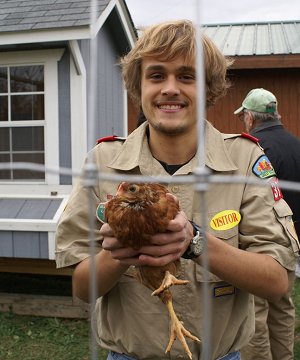-
Arrowhead Nature Zone
CHICKEN COOPDuring the spring of 2010 the Summit County Farm Bureau and the Arrowhead PTA together donated money to buy a chicken coop for the Arrowhead nature zone. The chicken yard was funded and built by Alex Stopar, a Copley High School student, as his Eagle Scout Project during the summer of 2010. This chicken project is a unique opportunity for teaching and learning.Arrowhead School now has 8 egg laying hens and one rooster. The eggs were placed in an incubator in the library and hatched the week of September 13th. The students will have the chance to see the chicks hatch and grow over the school year. Each class will spend 3 weeks caring for and learning about the different stages of a chicken’s life over the course of the school year. We have a variety of chickens so we can observe them and learn about what makes them different from each other and how they are similar. We will also be tracking the chicken’s growth by weighing the chickens weekly and tracking the number eggs produced by the chickens. When the chickens are about 19 weeks old (end of January), they will begin to lay eggs.The Arrowhead student council handled the gathering of various chicken names from the student body and the tallying of the chicken name ballets. The following names were chosen for the chickens: Oreo, Rosie, Rockstar, Lily, Daisy, Arrowhead, Pipsqueak, Chicken Little, & Peep. Check them out by clicking MEET THE CHICKS.Classroom chicken duties will involve providing food and water for the chickens along with holding and playing with the chickens. Holding the chickens will make them people friendly. A few children will be chosen from the class each day to help care for the chickens. The children will wash their hands before and after handling the chickens. Gloves will be provided to those that wish to wear them. Boots will be required to be worn when in the chicken yard. When the time comes for the chickens to lay eggs, eggs will have to be gathered and washed. The eggs will be prepared for the class to enjoy during their week of caring for the chickens.Check out the Chicken Facts below!
The arrival of the Chicken CoopNewly hatched chicks Chicken at 1 day old with Mr. LaBadieChicken at 3 days old Chicken at 4 weeks old Boy Scout & Arrowhead Alumni, Alex Stopar with Oreo Dedication of Coop, 2010
Boy Scout & Arrowhead Alumni, Alex Stopar with Oreo Dedication of Coop, 2010
Arrowhead at 11 weeks old!CHICKENS FACTS
Chickens are domestic or farm birds. The live span of a chicken is about 10 to 15 years. The male is larger and more brightly colored than the female. This is common feature in birds. The males show off their colorful feathers to attract the females.
A chicken has a comb on the head and two wattles under the neck. The male has a larger comb compared to the female. The male is called a rooster. The female is called a hen while the young are called chicks. The female is usually ready to lay her first eggs when she is around six months old.
The morning call your hear on the farm every morning is actually the rooster crowing "cock-a-doodle-doo". The female is called a hen and she goes "cluck-cluck". The young are called chicks and they go "chick-chick".
What do chickens eat?
Chickens eat worms, insects, seeds, grains, snails, slugs, fruits, vegetables and many other foods. The gizzard which is a part of the stomach contains tiny stones to help grind up the food.
Who are the chicken's enemies?
Animals like the hawks, bobcats, snakes, skunks, owls, raccoons, foxes and opposums prey on chickens.Breeds of chickens
There are approximatelty 175 varieties of chickens. They are grouped into 12 classes and approximately 60 breeds based on geographical areas :
- Asiatic, American, Continental, English, Mediterranean
See below for some of the different breeds :- Bantams. These are miniature chicken breeds.
- Plymouth Rock. Originated in the United States.
- Marans. They are small breeds preferred for their eggs rather than meat.
- Leghorns. Most popular commercial breed. Usually white in color.
- Rhode Island Red Chicken. This is a very popular breed of chicken. Usually raised for their meat and eggs and sometimes as show birds.
Life-Cycle of a chicken
The hen does not need a rooster to lay eggs. However, the eggs will not hatch because they are not fertilized. Chicken eggs come in different colors like white, brown, blue or bluish green and pink. Most chickens will stop laying eggs when the weather is cold. They will start laying when it gets warmer again.
How long does it take for a chicken egg to hatch?
A hen lays an average of 300 eggs per year. The hen will sit on her eggs to keep them warm so that they will hatch into chicks. A fertilized egg starts developing into a chicken when its temperature reaches 86 degrees farenheight. A chicken takes 21 days to hatch.

